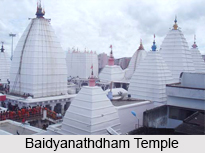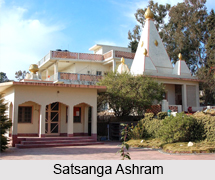 Tourism in Deogarh is largely influenced by religion as the region is a popular Hindu pilgrimage destination. It has the mixture of tribal cult and Hindu religion. Deogarh, the home of Gods, is steeped in history. Several temples and places of ritual were established to celebrate and worship the Gods and deities. Deoghar, which in Hindi literally means abode of the Gods. Deoghar houses the Baidyanath Temple, one of the twelve Shiva Jyothirlingams as well as one of the 51 Shakti Peethas in India. Tourism in Deogarh is well developed and has several popular destinations that attract tourists from all over the country through out the year. Baidyanathdham Temple, Nandan Pahar, Shivganga, Naulakha Mandir, Harila Jori, Satsanga Ashram are the tourist attractions of Deogarh.
Tourism in Deogarh is largely influenced by religion as the region is a popular Hindu pilgrimage destination. It has the mixture of tribal cult and Hindu religion. Deogarh, the home of Gods, is steeped in history. Several temples and places of ritual were established to celebrate and worship the Gods and deities. Deoghar, which in Hindi literally means abode of the Gods. Deoghar houses the Baidyanath Temple, one of the twelve Shiva Jyothirlingams as well as one of the 51 Shakti Peethas in India. Tourism in Deogarh is well developed and has several popular destinations that attract tourists from all over the country through out the year. Baidyanathdham Temple, Nandan Pahar, Shivganga, Naulakha Mandir, Harila Jori, Satsanga Ashram are the tourist attractions of Deogarh.
Tapovan
Tapovan, located 10 km away from Deoghar, has a Shiva temple which attracts several pilgrims. The temple is known as Taponath Mahadeva. A number of caves are also found in the hill.
Baidyanathdham Temple
Baidyanath or Shiva Temple is the most significant of all the temples in the region. The Baidyanathdham temple faces the east and is a simple rock-cut structure, along with a pyramidal tower, which is 72 feet tall. The summit has 3 ascending shaped gold vessels, which were donated by the Maharaja of Giddhaur, are efficiently set. Apart from these pitcher shaped vessels, there is also a Punchsula, 5-headed Trident, which is unique.
Chandrakanta Mani
Chandrakanta Mani, which is an 8-petal lotus jewel, is placed in the inner top. The Shiva lingam is installed inside, and has a cylindrical forming about 5 inches in diameter. The top of the lingam is damaged and has jagged surface. Bells affixed in the ceiling and pilgrims sound the bell in order to declare their advance to the divinity.
Nandan Pahar
Nandan Pahar is a small hill on the edge of Deogarh which houses a famous Nandi Temple. The temple vicinity is properly maintained by the local authority. Nandan Pahar faces the famous Shiv temple and has a large children`s park. There is also a boot house, a ghost house and a mirror house in here.
Satsanga Ashram
Satsanga Ashram is a sacred site for the devotees of Shri Shri Thakur Anukulchandra. The Satsang Ashram, located in the south-west region of Deoghar, was established by Sri Sri Anukul Chandra. The Ashram performs various reform and welfare activities for the society and for the improvement of humanity. Visitors from India and overseas come to the Ashram, through out the year.
Basukinath Temple
Basukinath Temple is a renowned Temple of Shiva. Basukinath is located around 43 km from Deoghar, close to the village of Jarmundi and is well connected by road. The Shiva Temple is indigenous and boasts local artworks.
Naulakha Mandir
 Naulakha Mandir is a beautiful spot, located 1.5 km away from Baba Baidyanath Temple. This temple looks like the temple of Ramakrishna Paramhansa in Belur. Inside it there are idols of Radha - Krishna. Its height is 146 feet. The amount spent in construction of the temple was about Rs. 900,000 (9 lakhs). Hence it became known as Naulakha Temple.
Naulakha Mandir is a beautiful spot, located 1.5 km away from Baba Baidyanath Temple. This temple looks like the temple of Ramakrishna Paramhansa in Belur. Inside it there are idols of Radha - Krishna. Its height is 146 feet. The amount spent in construction of the temple was about Rs. 900,000 (9 lakhs). Hence it became known as Naulakha Temple.
Ramakrishna Mission of Deogarh
This is a boarding school which is operated by the monks of Ramakrishna Mission. The campus is full of vegetation and has several sporting fields. The Ramkrishna Mission Vidyapith was set up in 1922 with the objective of imparting modern education along with the values of ancient culture.
Rikhia Ashram
Rikhia Ashram, which is a Bihar School of Yoga was established by Swami Satyananda Saraswati. A yearly fair, festival and ceremony, is held in November-December and attracts numerous devotees from various corners of the globe. The ashram is a holy place and the charitable deeds hugely benefit the local villages.
Shivganga
Shivganga is basically a pond located almost 200 m from Baidyanath Temple. According to the legends of Ramayana, Ravana created the water body by punching the earth and water came out and formed a pond.
Trikut Pahar
Trikut Pahar, 2,470 feet in height, is situated 13 km away from Deoghar and the presence of three main peaks on the hill attributes to the name Trikutachal. Trikutachal Mahadeva Temple, a temple of Shiva, is present in the Trikuth Parvat. There is also an altar of the goddess of Trishuli. It is an attractive place with a cool stream flowing.
Prabhu Jagadbandhu Ashrama
The ashram has a stone-temple of Prabhu Jagadbandhu. This small ashram is beautifully adorned with flowers and situated within a pristine landscape.
Ram Nivas Ashram
Ram Nivas Ashram is covered by trees and gardens and contains temples of Tripura Sundari, Radha-Krishna, and Bhagbati Devi. Sri Sri Balananda Brahmachari Maharaj used to reside here.



















